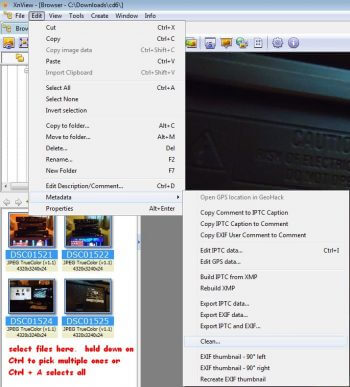

This has become the de facto standard for most embedded metadata. For a complete list see Adobe products with Adobe Bridge.Īdobe Bridge creates the data in XMP, Extensible Metadata Platform, which is based on XML.
REMOVE METADATA USING METAZ MP4
If you’re fortunate to have a newer version of Adobe Creative Suite, you already have an application called Adobe Bridge which is “the control center for Adobe Creative Suite.” This application enables file organization and provides the ability to add metadata to AVI and MOV files, but not to MP4 files.Īdobe Bridge is also included in Adobe Photoshop CS5, Illustrator, Flash, Premiere, After Effects and others. The MetaSync feature is now standard within Windows-based versions of Avid’s Media Composer and NewsCutter. Avid’s MetaSync and Adobe’s Bridge are two examples.Īvid’s MetaSync technology allows users to synchronize virtually any kind of metadata with video and audio content during post production.
REMOVE METADATA USING METAZ SOFTWARE
Today all professional video editing software has access to metadata. Otherwise the typical log of video shots is only valuable to the person who knows the location of it. This way your notes and descriptions won’t be lost when you move, copy or email a clip. Since logging footage is a customary part of video editing, you may as well put shot logs, ratings and lots of other information on each clip as metadata. The descriptions enable searches of video content and give users more information about a video. YouTube, like all video sharing sites, requires metadata for videos that are uploaded. It’s hard to imagine YouTube without the descriptions or metadata that describes any video. Video metadata has great potential for marketing. But manually written metadata created by humans is growing and becoming more important. Most of the current video metadata is the automatically created metadata. Gaining higher search engine visibility will bring more viewers and enable marketing opportunities. These text entries are understandable by computers and provide efficient searching. This can be transcripts of dialogue or conversations and other text descriptions. Two exceptions are correcting a camera’s date/time setting and adding GPS data.Ģ) Manually written video metadata which provides information about the video content. Most EXIF data cannot be edited after capture.

The standard format is Exchangeable Information File Format (EXIF). It stores camera-created information such as aperture, shutter speed, GPS coordinates and more in the video file.

Whenever you copy, email, or publish your file, all its file information or metadata travels along with it.ġ) Automatically collected video metadata from software or a device like your video camera. It’s attached to the file and can include copyright information, author, keywords, file size, media format, people, place, closed captioning and subtitling information, and lots more. Metadata is itemized information about a file. This is an amazing adventure and the best way to pay for video equipment! Earn the respect of small businesses, corporations and non-profits who rely on your expertise. Start part-time or full-time in this lucrative and satisfying work. Clever producers use keywords in the name of their video files, but without some additional text, computers have a hard time understanding the content of a video. It is the keywords that computers and search engines use to search for content in videos. Metadata for video is particularly helpful because video, unlike a document, does not include keywords as text.


 0 kommentar(er)
0 kommentar(er)
